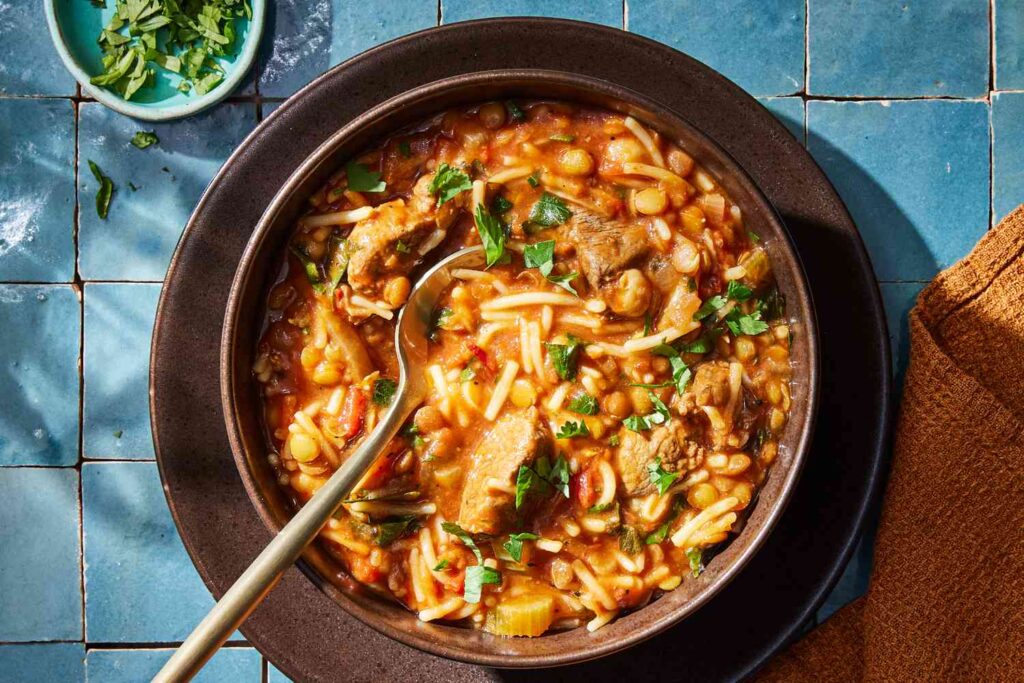For approximately one month each year, Muslims around the world celebrate Ramadan through various traditions and rituals. Many traditions around Eid al-Fitr and Ramadan involve donations to charity, scheduled prayers and recipes that have been passed down for generations. Even though I was born and raised in Washington state, thousands of miles away from my extended family in Morocco, my dad preserved these traditions through food like mechoui (slow-roasted lamb), vegetable salads, chebakia (sesame cookies) and harira. Harira is a tomato-based soup featured at the center of our Moroccan iftar table (the meal served to break the fast each day) during the month of Ramadan, fueling our bodies after a long day of fasting. While it’s not uncommon to serve this soup outside of the holiday, I can’t help but be reminded of these traditions whenever I enjoy a bowl.
Most of my Ramadans were spent in the United States, but my brother and I often reminisce over shared memories of times we spent celebrating Ramadan and Eid al-Fitr in Morocco. Ramadan itself felt like a daily challenge, with the excitement of waking up early to grab a bite before the sun rose, days spent preserving energy when possible, family dinners at sunset and a heightened appreciation for our food and our ability to challenge our minds and bodies. Sometimes we would have a heartier dinner like tagine with a salad, but most nights it was some combination of this traditional Moroccan spread: dates, milk, hard-boiled eggs, semolina pancakes, sesame cookies, tea and harira.
The end of the holy month of Ramadan, also known as Eid al-Fitr, held a different energy (and menu) entirely. Our extended family would gather together, traveling from Marrakech and Casablanca, to celebrate by sacrificing a lamb on the rooftop of my grandmother’s apartment. I remember the entire city of Rabat had a buzz to it that was unlike anything I’ve ever experienced. My uncles and dad would spend the morning slaughtering the lamb while my aunts and grandmother were busy preparing vegetable salads, cookies and various dishes featuring the lamb. Any parts of the animal that weren’t featured on the menu that evening were carefully processed and stored for future use. It was a day of complex emotions for me as a kid who got personally attached to animals all too quickly. Getting to spend time on the rooftop with the lamb before the sacrifice taught me a new level of appreciation and respect for the food on our table.
Our Ramadan and Eid al-Fitr traditions spent at home in the United States were mellow in comparison, but still something we looked forward to every year. My dad would find the best quality meat to use to make big batches of harira for us to enjoy after sunset. We used the special cookie cutters he brought home from Morocco so we could make chebakia together. We even had our own set of walnut spoons, traditionally used when enjoying our harira. While our parents didn’t require my brother and I to fast, we would challenge ourselves to do so a few days each Ramadan, finding a sense of pride in sharing our traditions with curious peers at school. Even though we were more secular, practicing these rituals helped us to feel closer to our family in Morocco, and closer to our roots. It gave us a sense of humility and accomplishment.
To this day, I hold a deep appreciation for these lessons, especially during the month of Ramadan. If you’re interested in exploring this holiday through a Moroccan lens, I invite you to try this recipe, learn more about the holy month of Ramadan, and find a new appreciation for the Quran’s teaching that “with hardship comes ease.”
Photographer: Rachel Marek, Food stylist: Lauren McAnelly, Prop stylist: Gabriel Greco
